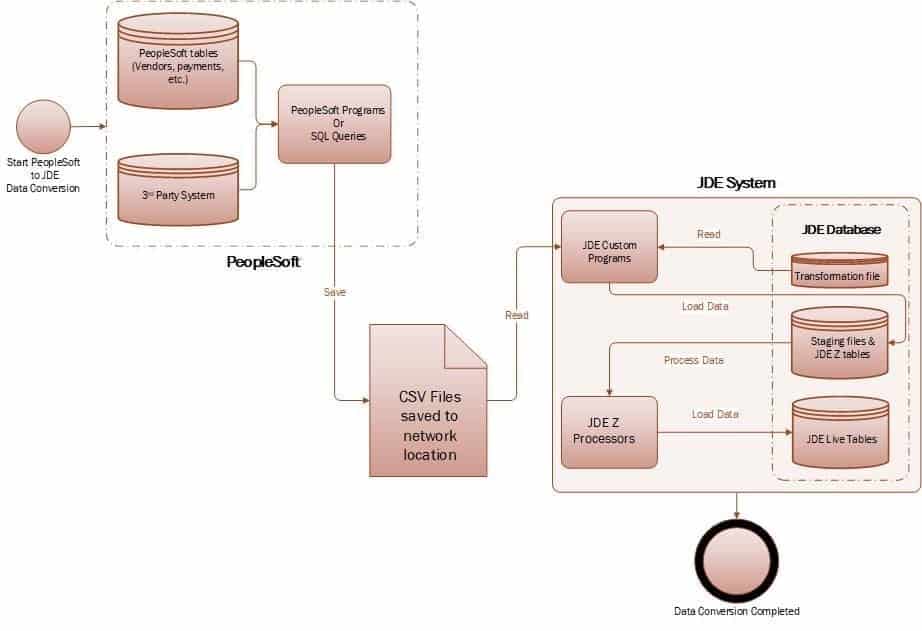PeopleSoft To JD Edwards
Data Conversion
I recently gained the opportunity to work on a migration project for one of our clients, where I was assigned the task of initiating a PeopleSoft to JD Edwards data conversion. Through this project, I learned the process of data conversion, the strategy behind it, general challenges faced, and how to identify opportunities for future migrations. In this article, we look at each aspect in detail.
The Importance of Data Conversion
For an organization, data is an asset that takes years to gather. When there is a change in the system (in this case PeopleSoft to JD Edwards), the data stored in the legacy system needs to migrate to the new system. Generally, different systems store, support, and retrieve data in their own unique way. Sometimes there are multiple sources of data, which adds complexity to the data conversion process.
A poor data conversion leads to project failure, as well as wasted effort, time and money. Many projects miss the deadline and go over budget due to poor data conversion, sometimes failing completely. In addition, the performance of the new system depends on data conversion, so this aspect is especially key in the long run.
Challenges in the Data Conversion Process
There are various challenges faced during the process. In our case, the PeopleSoft to JD Edwards data conversion process was no exception. The common challenges are:
The Data Conversion Strategy
As previously discussed, our team studied the business process and came up with the list of data sets that need to be migrated. These included data for vendors, customers, franchisees, open balances, open payments, branch plants, and assets. We decided to use a standard JDE-Z process to migrate data to main tables. For this, some custom programs were developed.

First, data is extracted in pipe delimited test files. Then, custom programs read these files and dump this raw data in custom JDE tables. These custom tables work as a staging place for the data, which also gives way to check and verify results. Once all data is loaded to the staging area, custom JDE Universal Batch Engines (UBEs), massage the data based on the rules defined, and load the records into the respective JDE-Z tables.
Business analyst have the opportunity to verify how the records were created in the new system before finalizing. Here, programs use transformation rules for User Defined Codes (UDCs), as the JDE system use UDCs that are different from PeopleSoft. In this process, a custom application was created where the module team could configure rules independently. This gave flexibly to set up new transformation rules, and modify existing rules as need. This application is a central place for all transformation rules across different conversion programs.
This strategy was used for the following reasons:
Opportunities Identified
This project was also an opportunity to fix various data related issues in the legacy system. As this data was accumulated over the years (and by various processes), there were many inconsistencies identified. These are as follows:
The Importance of Data Conversion
There were six User Acceptance Tests (UTAs) that were planned for the project. There were changes expected, but all were fixed quickly because of the robust design and use of JD Edwards development technology. No major changes/issues were identified in the converted data as well. Altogether, the project was delivered on time and within budget.
In short, data conversion is a very important aspect in many ERP implementation projects. Further, projects can be delayed and go over budget because of poor data conversion. This process should be planned in the early phase of the project to ensure success. It is key to keep the data conversion program (technology) simple, as these are run only once, just before go-live. Once you’ve converted all required data, these programs are no longer needed, so do not exhaust too much effort on the program itself. Rather, focus on the overall design so the converted data is clean and complete.
Looking for more on JD Edwards?
Explore more insights and expertise at smartbridge.com/jdedwards/.
Keep Reading: Smart Fields on JD Edwards Custom Reports
There’s more to explore at Smartbridge.com!
Sign up to be notified when we publish articles, news, videos and more!
Other ways to
follow us:


